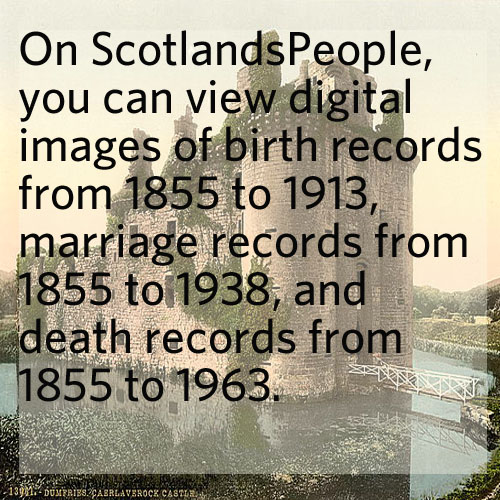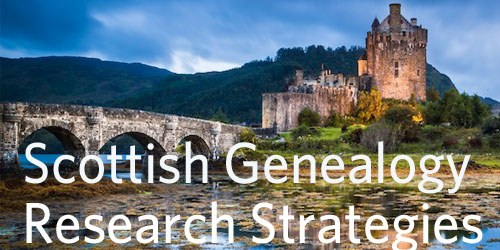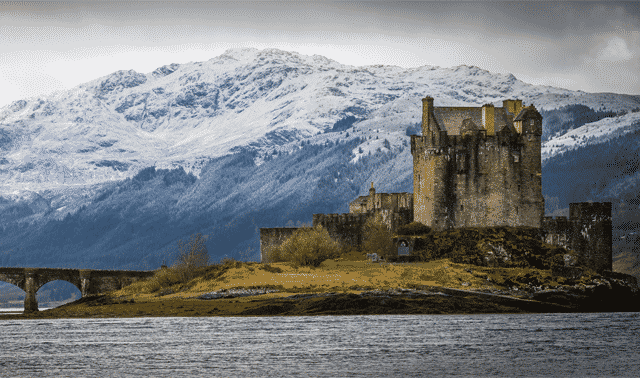Sign up for the Family Tree Newsletter! Plus, you’ll receive our 10 Essential Genealogy Research Forms PDF as a special thank you.
I hit the genealogical jackpot early on in researching my Scottish ancestors. One of my mom’s cousins arrived at a family reunion with papers found at the bottom of a dresser drawer. In 1880, a great-grand-uncle of mine transcribed all of the Robertson family papers, beginning with the 1780 marriage of Edward Robertson and Mary McGrigor in Scotland.
The transcribed papers include documents the family brought from Scotland in 1804; among them, church elders’ affirmations that the Robertsons were of good moral character and should be accepted into any congregation they might wish to join. All the names, dates and references to specific places in Scotland made it easy for me to find out more about my family in Scottish records.
Even if you don’t have that kind of a head start, you’ve got a big break when researching Scottish roots: Scotland is one of the few countries whose genealogically useful records are almost entirely online and well-indexed. Vital, church, census and probate records are all easily accessible with a few clicks.
They’re not free, but the reasonable fees are a small price to pay for that kind of convenience. You wouldn’t expect those thrifty Scots to give away their records for free, would you?
Once you’ve gathered all the clues you can find on your Scottish immigrant ancestors, you’re ready to search for their records. All of Scotland’s most important resources are on the country’s official records site,
ScotlandsPeople and several other websites also have important collections. Here’s a rundown of the key Scottish genealogy records and where you’ll find them.
Discover Vital Details
Among the first Scottish genealogy records you’ll use are records of births, marriages and deaths, kept most recently by the government, and before that, by the church. You can access both online:
BIRTH, MARRIAGE AND DEATH CERTIFICATES (1855-2012):
Government registration of vital events, called statutory registers, began Jan. 1, 1855. At first, officials were supposed to record very detailed information, a practice that proved hard to maintain, so the requirements were scaled back. Starting in 1856, birth records provide the child’s name, date and place of birth, the father’s name and occupation and the mother’s maiden name. The date and place of the parents’ marriage was added in 1861.
Marriage records from 1856 and later provide the date and place of marriage; the names, ages, marital status, occupations and places of residence of the bride and groom, plus the names of the couple’s parents (including the mothers’ maiden names).
Death records provide the deceased’s name, age and occupation, plus the date, place and cause of death. The burial place was included up to 1860, and the spouse’s name was required starting in 1861.
ScotlandsPeople has indexes to birth, marriage and death records from 1855 to 2012. You can view digital images of birth records from 1855 to 1913, marriage records from 1855 to 1938 and death records from 1855 to 1963. Access to images of recent records is restricted: 100 years after the date of the record for births, 75 years for marriages and 50 years for deaths. You can, however, order certified extracts of restricted records from the ScotlandsPeople website.
Image credit: (ca. 1890) [Caerlaverock Castle, Dumfries, Scotland]. [between and Ca. 1900] [Image] Retrieved from the Library of Congress, https://www.loc.gov/item/2001705977/.
CHURCH OF SCOTLAND RECORDS (1538-1854):
Church records are your primary source of birth and marriage information in Scotland before government registration began. The Presbyterian Church, established as the national church in 1690, is known as the Church of Scotland. Its historical records are called the Old Parochial Registers, Old Parish Registers or for short, OPR.
Each local parish kept records. A few church records in cities survive from the 1500s, but in most places, they don’t begin until the mid to late 1700s. Some records have been lost and there are many gaps. Early parish registers may be in Latin, and you might encounter unfamiliar terms and spellings even in English records. You’ll find a
Latin genealogy word list here.
An OPR baptism record may include the child’s name, whether the birth was legitimate, dates of birth and baptism, father’s name and occupation, mother’s maiden name, parents’ place of residence and witnesses’ names. An OPR marriage record usually includes the names of the bride and groom and their parish of residence. Sometimes it also provides the groom’s occupation and the name of the bride’s father. In addition, it might note the date of the proclamation of banns, or the notice of contract of marriage read out in the church (kirk) before the marriage took place.
Surviving OPR death and burial registers may include just the deceased’s name and the date of death, burial or payment for a mortcloth draped over the coffin during the funeral.
The sparse information can make it hard to determine whom a record refers to, especially if it’s a common name. ScotlandsPeople has indexes and images of all existing OPRs from 1538 to 1854. Most Church of Scotland births, christenings and marriages before 1855 are also indexed on FamilySearch.org in Scotland, Births and Baptisms, 1564–1950 <
www.familysearch.org/search/collection/1771030> and Scotland, Marriages, 1561-1910 <
www.familysearch.org/search/collection/1771074>. The same databases are on Ancestry.com and World Vital Records. Searching works differently on each site, so if you don’t find your ancestor on one, try another.
Using the default settings, ScotlandsPeople and Ancestry.com don’t find a match on Edward Robertson and Mary McGrigor, married in 1780. FamilySearch.org turns up their marriage, even though Edward’s last name is spelled Robison.
Once you find a promising christening or marriage in an index, check the original record for additional details. According to the index on FamilySearch.org, Edward Robison and Mary McGrigor, daughter of John McGrigor, married July 22, 1780, in Drymen, Stirling, Scotland. The entry also gives the numbers of the microfilm with the record image, so I searched for them in FamilySearch’s online catalog <www.familysearch.org/catalog-search> and rented the film for viewing at my local FamilySearch Center. (Now that the records are online, though, it’s easier to view them on ScotlandsPeople than on microfilm.) The church register states, “July 22d Edward Robison in Ardihoil Killin parish and Mary McGrigor Daughter of John McGrigor in Auchaillee. Listed for Proclamation of Banns on the twenty-second of July [1780].” So I learned the groom’s parish of residence (Killin) and the hamlet (Ardihoil) within the parish, plus the bride’s father’s parish (Auchaillee, aka Auchaltie).
Local parishes also kept kirk session records, which include information not found in parish registers, such as details about illegitimate births and alleged fathers, as well as mortcloth fees (which might be the only evidence of a death).
Most of these records aren’t online or microfilmed. Search the FamilySearch Wiki <
wiki.familysearch.org> for a parish name to find out whether kirk session records exist and where they’re held. For details on the repository, search for the parish name in the Scottish Archive Network Online Catalogue <
www.scan.org.uk/catalogue>. You’ll probably need to visit the archive or hire a researcher to access the records.
NONCONFORMIST CHURCH RECORDS:
People who didn’t adhere to the teachings of the Church of Scotland, including Baptists, Methodists, Episcopalians and Catholics, were considered nonconformists. Check the parish page in the Family Search Wiki for information on nonconformist church records. Nonconformists weren’t authorized to perform marriages before 1834, so you might find these marriages in Church of Scotland records.
ScotlandsPeople has records from the Scottish Catholic Archives. Births and baptisms include all surviving records from 1703 to 1855, and incomplete records from 1855 to 1908.
Most records begin in the 1790s and some are in Latin. The earliest banns and marriage records date from 1736, but most of them begin in the 1800s. Like those of the Church of Scotland, Catholic death and burial records are sparse.
Catholic baptismal registers may include the child’s name, dates of birth and baptism, legitimacy, father’s name and occupation, mother’s maiden name, their place of residence and witnesses’ names. Most marriage registers record only the bride’s and groom’s names and marriage date. Death and burial registers give the deceased’s name and date of death or burial, and sometimes age, address and a relative’s name.
Count on Censuses
Every 10 years since 1841 (except 1941), Scotland has taken censuses recording everyone by name. These records are closed to the public for 100 years, so the 1911 census is the most recent one you can view.
The 1841 census shows just names, ages, occupations and places of birth. The ages of people 15 years and over are rounded down to the nearest five years, so a 63-year-old would be recorded as 60. Details on place of birth are less specific than in later years, indicating only whether the person was born in the county where the census took place, or whether the person was English, Irish or foreign.
Starting in 1851, censuses include more details. Household numbers make it easier for you to separate families. You’ll find a person’s relationship to the head of the family, actual age, parish of birth and marital status. Keep in mind that married women are usually recorded with their married name in census records, but sometimes the maiden name is used. A widow might also have reverted to her maiden name. ScotlandsPeople is the only website with images of census records from 1841 to 1911. All years are indexed. FamilySearch.org has transcriptions from 1841 to 1891 and fee-based sites Ancestry.com, findmypast.com and Genes Reunited have transcriptions from 1841 to 1901.
Probe into Probate Records
Probate records concern the distribution of a deceased person’s estate. Until 1868, Scottish law stipulated that real estate should go to the eldest son or, if there was no son, to any daughters equally, and then to the surviving spouse. A property owner couldn’t write a will to bequeath land or other goods, but could leave personal property to heirs by means of a testament. Testaments may provide a date of death, as well as names and residences of heirs, relationships and estate inventories. Because strict rules governed the distribution of personal property, however, there was often no need to name a widow, widower or children. Nobility, merchants, tradesman and other members of the middle and upper classes made most testaments. I haven’t found testaments for any of my Scottish ancestors, but it’s worth seeking them, regardless of your ancestors’ social standing.
Starting in 1868, Scots could bequeath both real and personal property in wills. ScotlandsPeople has an index to 611,000 wills and testaments from 1513 to 1925 and images of the records. The index covers only decedents, not executors, trustees or heirs. You can search it for free, but it costs 10 credits (about $2.90) to view a document. My ancestor David Ferguson lived near the village of Thornhill in the parish of Kilmadock, Perthshire, Scotland, so I suspected he was the David Ferguson of Thornhill whose 1799 testament is indexed on ScotlandsPeople. I downloaded the two-page document, which provides few details. It indicates that David Ferguson died before March 23, 1797 and that Andrew Wright owed him money. It refers to his nephew, John Ferguson, as his “nearest in kin,” which suggests that this David left no surviving children and wasn’t my ancestor of the same name.
Picture the Places
Because Scotland has nationwide indexes to all its major records, you don’t usually need to know exactly where your ancestors lived to research your family history. But once you discover the names of their cities, villages, parishes and small settlements, you can learn a lot about those places using online maps and gazetteers. Scotlands Family <www.scotlandsfamily.com> has good maps of Scotland, including county maps showing parish boundaries.
If you have just the name of a farm or small hamlet, try to find the parish it’s in and locate the place on a map. Be prepared for nonstandard spellings and poor handwriting to confound your eff orts. The 1880 transcription of the Robertson family papers begins with the marriage record of Edward Robertson of Ardchoill in 1780. In the parish record of the marriage, the place name looks like Ardihoil. Fortunately, a researcher in Scotland who was familiar with that area explained that the hamlet, also spelled Ardekyle, Ardchyle and other ways, is located in the parish of Killin four miles southwest of the village of Killin. She described the two remaining houses, one built in 1900 and the other an older cottage, and a few scattered ruins. Use the Scottish genealogy discussion forums listed in the sidebar for help finding a person familiar with rural settlements and farmsteads where your ancestors lived.
ScotlandsPlaces <
www.scotlandsplaces.org.uk> is the best site to locate small settlements. A search on Ardchoill turns up nothing, but Ardchyle produces four matches. One is a 1900 black-and-white photo of thatched buildings. Another match shows the place on a modern color map. Though the site instructs you to “Click on map for a larger view,” you need to click that phrase, not the map. You can view the same color maps on StreetMap <streetmap.co.uk>, where they’re easier to use and you can save larger maps.
Other matches for Ardchoill on ScotlandsPlaces include links to old Ordnance Survey maps produced at 6 inches to the mile and 25 inches to the mile. A link to “View and order image in NLS” opens a larger map. You’ll have to browse around to find the place; use the plus sign to zoom in. Click on Print View to print the map. To save a section of a map, you can do a screen capture or use the Windows Snipping Tool. Click on Order This Map to order a printed copy of the whole map. The A1 option (23.4×33.3 inches), the largest size that can be delivered outside the United Kingdom, costs about $30, including shipping.
A search on Edward Robertson’s home parish of Killin produces 273 matches, including a detailed description in the volume from 1803:
“KILLIN; a Highland parish of Perthshire…The situation of the village of Killin at the W.[est] end of Loch Tay, is singularly picturesque and pleasant. Near it the Dochart and Lochy [Rivers] unite, and fall into the loch; and the romantic surrounding hills, skirted with wood, all increase the beauty of the scene.”
For an insight into daily life in your ancestor’s hometown, check the Statistical Accounts of Scotland <
edina.ac.uk/stat-acc-scot>, written between the 1790s and 1840s. The 1790s report on Killin says, “Gaelic is the language generally spoken … but most of the younger people understand less or more of the English language.” So now I know that Edward Robertson probably spoke Gaelic.
A Google <
google.com> search also can turn up a lot of fascinating material on your ancestral hometown in Scotland. Search on the parish name Killin and you’ll find a Wikipedia article stating that, in the late 18th century (when my ancestors lived there), “Flax was grown locally, spun in small mills and woven into linen by home-based weavers.”
Image matches include picturesque scenes showing the River Dochart. Click on the Maps tab in your Google search results to view (in addition to a map) photos, photo tours and Street View. Also be sure to search on your ancestor’s parish name plus the word church. I found exterior and interior photos of the Killin parish church, built in 1744. It’s awe-inspiring to look on those images, as well as the bucolic scenes of lush forests, stone bridges and magnificent waterfalls—the same landscapes my ancestors regarded more than two centuries ago.
Websites
Ancestry.com <ancestry.com> $: census transcriptions; indexes to birth, baptism and marriage records; message boards
FamilySearch.org <
www.familysearch.org>: census transcriptions; indexes to birth, baptism and marriage records; how-to videos and articles
National Library of Scotland <
www.nls.uk>: guide to family history research, gazetteers, maps and directories
World Vital Records <
www.worldvitalrecords.com>: indexes to birth, baptism and marriage records; books on Scottish immigrants
More Resources
Family Tree Shop
Scottish Genealogy Crash Course on-demand webinar
A Genealogist’s Guide to Gaelic Names ebook
From the September 2014 issue of Family Tree Magazine.







